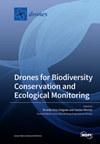The Detection of Tree of Heaven (Ailanthus altissima) Using Drones and Optical Sensors: Implications for the Management of Invasive Plants and Insects
IF 4.4
2区 地球科学
Q1 REMOTE SENSING
引用次数: 0
Abstract
Tree of heaven (Ailanthus altissima) is a highly invasive tree species in the USA and the preferred host of an invasive insect, the spotted lanternfly (Lycorma delicatula). Currently, pest managers rely solely on ground surveys for detecting both A. altissima and spotted lanternflies. This study aimed to develop efficient tools for A. altissima detection using drones equipped with optical sensors. Aerial surveys were conducted to determine the optimal season, sensor type, and flight altitudes for A. altissima detection. The results revealed that A. altissima can be detected during different seasons and at specific flight heights. Male inflorescences were identifiable using an RGB sensor in the spring at <40 m, seed clusters were identifiable in summer and fall at <25 m using an RGB sensor, and remnant seed clusters were identifiable in the winter at <20 m using RGB and thermal sensors. Combining all seasonal data allowed for the identification of both male and female A. altissima. This study suggests that employing drones with optical sensors can provide a near real-time and efficient method for A. altissima detection. Such a tool has the potential to aid in the development of effective strategies for monitoring spotted lanternflies and managing A. altissima.使用无人机和光学传感器探测天堂树(Ailanthus altissima):对入侵植物和昆虫管理的影响
天堂树(Ailanthus altissima)是美国的高入侵树种,也是入侵昆虫斑灯蝇(Lycorma delicatula)的首选寄主。目前,害虫管理者只能依靠地面调查来检测海棠和斑潜蝇。本研究旨在利用装有光学传感器的无人机开发高效的工具,以检测斑潜蝇。研究人员进行了空中勘测,以确定检测 A. altissima 的最佳季节、传感器类型和飞行高度。结果表明,在不同的季节和特定的飞行高度都能探测到 A. altissima。使用 RGB 传感器可在春季小于 40 米的高度识别雄花序,使用 RGB 传感器可在夏季和秋季小于 25 米的高度识别种子簇,使用 RGB 和热传感器可在冬季小于 20 米的高度识别残余种子簇。综合所有季节数据,可以识别雌雄A. altissima。这项研究表明,使用带有光学传感器的无人机可以提供一种近乎实时和高效的方法来检测 A. altissima。这种工具有可能帮助制定监测斑灯蝇和管理斑灯蝇的有效策略。
本文章由计算机程序翻译,如有差异,请以英文原文为准。
求助全文
约1分钟内获得全文
求助全文

 求助内容:
求助内容: 应助结果提醒方式:
应助结果提醒方式:


